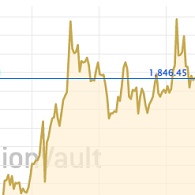Average US Incomes in Gold
How the average US income looks through the Gold Price, not post-1971 funny
money...
THIS IS something I've been mentioning a lot recently, says Nathan Lewis at New World Economics.
This shows the US
government's own statistics on the median male
full-time income in the United States. I use this because it compensates for a lot of things that have
been going on, such as
increasing female participation in the workforce, changing demographics or family size, or
greater/lesser part-time
work.
These are also "real" statistics, which means the data have been adjusted by the
government's version of price
statistics – which have been buffed and polished to look as good as possible. If the price statistics
showed an additional 1% of price
rises per year, over forty years, this chart would look a lot worse.
The interesting thing
here is how there is such a
definite inflection point, right where we go from a gold standard system to a floating currency system.
A lot of other things have
happened over that time, but we don't see any other major inflection points.
You might think
that the 1990s were really
good for people, and the 2000-to-present era has been not so good. But oddly enough, there's no
particular difference you can see on
this graph (although maybe the government is monkeying the statistics more aggressively since 2000
present to make it look that
way).
This is one reason why I think that the transition to funny money in 1971 is probably
the most important long-term
event for middle-class prosperity in the United States. On the chart above, you can also see how the US
middle class steadily
prospered in the 1950s and 1960s, despite the various ups and downs of the economy, not to mention
social turmoil, of that time
period.
But what about median incomes in terms of that pre-1971 money, physical
gold?
Here is the same information, but here I've portrayed the value of the
median annual income in terms of ounces of gold.
This is not so weird, because the US used
gold as the universal standard
of value for 182 years, until 1971. So I'm just being a traditionalist here. And this chart is plain
ugly, which is why, I think, that
even though we have transferred from a one-income household to a two-income household, the average
American family still can't afford
today what one median income could buy in the late 1960s.
Here is some long-term data, the per-capita
GDP as measured in ounces of gold (ie, the Dollar figure
divided by the per-ounce Gold Price). Any GDP statistics from before 1950 are highly suspect, and that
is especially true of figures
from before 1914. So, consider this suggestive rather than definitive. It tells much the same
story.
I
smoothed things out a bit here by looking at average
growth rates over forty-year time periods. Was the average American better off (as measured in
per-capita GDP in gold ounces) than
they were forty years earlier?
You can see that, even despite hardships such as the Civil War
and the Great
Depression/World War II, the average American was consistently better off than they were forty years
previous. The Great American
Wealth Generation Machine kept on ticking, even after huge setbacks.
We haven't had any
Civil-War-scale disasters since
1971, but the funny-money environment has nevertheless disabled the Great American Wealth Generation
Machine. The average American is
now, for the first time in US history, consistently worse off (by this measure) than they were forty
years ago.
Looking
to Buy Gold for your investment savings today...?












 Email
us
Email
us
